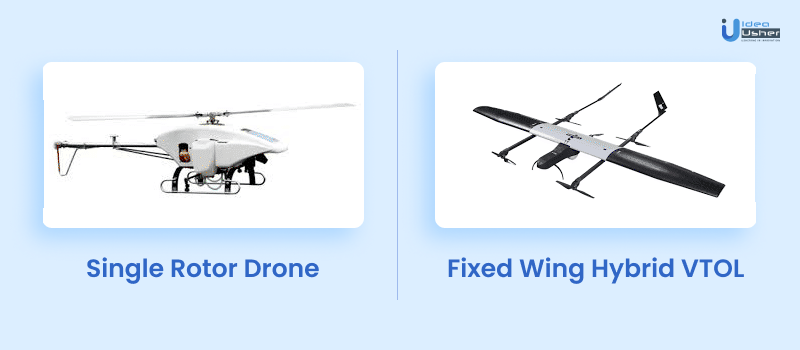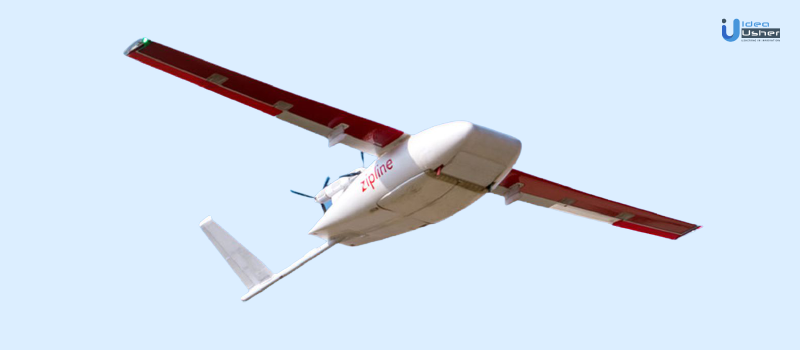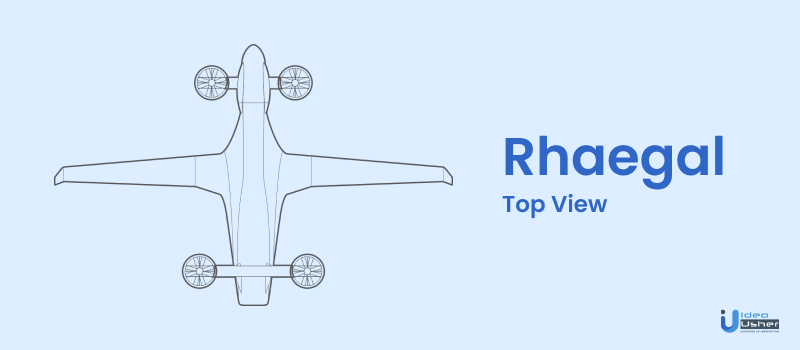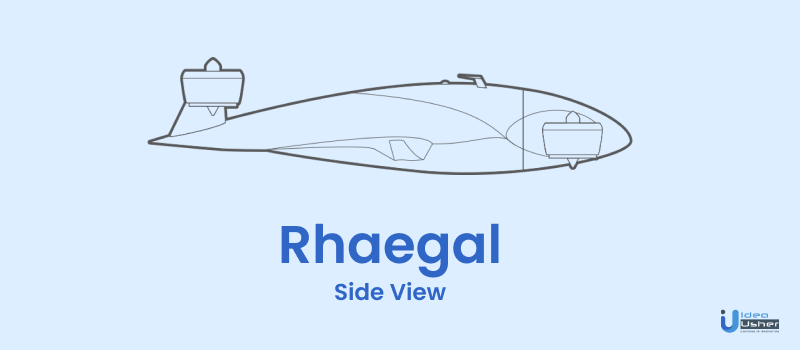
So, how does drone delivery work? Drone delivery is an idea that has been around for a while now. Companies like Amazon and Wing have been experimenting with the concept for a few years. Why? Simply because it will save them a lot of time and money.
Also, it will allow them to reduce the number of employees, which will lead to fewer administrative hiccups and lesser complaints. So it is far easier to manage a fleet of drones.
There are various types of drones that can be used in the near future. Some of them are shown below:


Possible benefits of using drones:
Using drones for all deliveries is a great challenge, and one might wonder why don’t we just let the thing be as is. Well, as it turns out, there are many benefits of using drones that outweigh the prospect of not trying.
The top 4 benefits of using drones for deliveries are:
1. Quicker Delivery Times:
A quicker delivery time is one of the top reasons companies are trying to incorporate drones into their business model. Companies like Amazon and wing are testing out 30 minute delivery times. So, even the same-day delivery model is soon going to be obsolete.
Drones will pick up the stuff from the amazon warehouses and deliver it to your home within 30 minutes, which is unthinkable by today’s standards. From the click of a button to a tangible object in your hands will take less than half an hour.
2. Reduced Costs:
The final few miles of the package are the most expensive to the company. It needs a fleet of employees, trucks, managers, customer care executives, and many more facilities to deliver a single item.
This costs the company a lot of money. However, if they can use drones, they will be able to cut down on fuel, employee salaries, types of equipment, and much more.
This is one of the primary reasons why companies want to use drones as early as possible.
3. Reduction of Traffic:
This is the cherry on top of the cake for drone delivery systems. With the incorporation of drones, the traffic that comes with delivering the goods will be cut down drastically.
Some reports suggest that trucks cause28% of the congestion on American roads. The entry of drones will cut down most of this traffic over time and make our lives just a little bit easier.
4. Eco-Friendly:
It is an obvious benefit of using drones, as it does not use any fuel. Batteries are used in all types of drones, making them much more economical as well as eco-friendly.
This will contribute to making the air cleaner and better for humans, animals, and plants.
How does drone delivery work?
To look at how the drone delivery system works, we need to look at how a package from, say, Amazon arrives at your doorstep starting from the point you place the order:

The most expensive part of this entire chain is the last few miles because you can carry thousands of goods in a shipping container, but in a truck, only a few dozen. So it accounts for the maximum cost.
Instead, drone delivery would work something like this:

Drones cut out the cost completely; it delivers individual packages to your home faster and cheaper. So let’s look at how does drone delivery works and how it’s so appealing to e-commerce giants:
1. Take Off:
After the order is received, the item is packed in the nearest company warehouse, and it is dispatched using a special package designed to be hung to a drone.
The drone takes off from the warehouse and with the package and leaves for the customer’s house.
Most drones function as per the VTOL process, which means vertical takeoff and landing. However, companies like Zipline have succeeded in creating a noon VTOL craft that functions very efficiently too.
2. Navigation:
This is perhaps the most critical stage of the drone delivery process; it needs to navigate its way through populated areas to the customer’s house.
Various drones use various methods, but GPS navigation is a common feature that they all use to locate the customer’s house. There are cameras mounted on the drones that function as its eyes and SONAR/ RADAR tech that work as its ears.
This makes the drone intelligent enough to navigate through populated areas, identifying and avoiding obstacles like trees, lamp-posts, buildings, and other drones.
3. Package Drop-Off:
Assuming that the drone has reached the customer’s house safely, there are three primary ways a package can be delivered:
- Chord and Packet System: The drone finds a safe location on the customer’s property to lower the package; an area set by the customer or a mat with a QR code placed on the drop location by the customer can help to identify this. The camera of the drone will scan the code and identify it as a safe drop-off location. Then the package is lowered using a chord on the mat.
- Fly-By: The drone does a fly-by over the customer’s house and releases the package, which parachutes down to the owner’s house. The problem with this type of delivery is that it is too risky for fragile items. However, it is faster than the chord mechanism.
- Complete landing: the drone lands on the landing spot, unlatches the package, and takes off again.
After the delivery of the package, the drone needs to navigate back to the base. Let’s look at how it does that.
4. Returning to Base:
The drone navigates back to the base, which is the company ware whose and prepares itself for the next delivery by resetting the systems and cross-checking how much power is left in the battery.
Companies experimenting with drone delivery systems:
Many companies are experimenting with drone delivery systems and trying to understand how does drone delivery work:
1. Amazon.com

To understand how Amazon’s drone delivery works, we need to look at what Amazon has done in the UK. Amazon has started its prime air trials in the UK already. It uses a quad/hexacopter-designed drone with VTOL, which navigates its way to the customer’s house, drops the package, and heads back for the warehouse.
The drones are completely autonomous and make a 30-minute delivery possible. The drones will cruise below 400 feet, with a carrying capacity for low-resolution of 5lbs.
2. Wing.com

Wing uses a drone with 12 propellers on top and two mounted horizontally on the drone’s wings. With a latch that holds only a particular type of package designed to fit the drone perfectly.
This package is dropped off at the customer’s house using the chord and packet system. The drone technically doesn’t land at all. It stops over the delivery spot, hovers over it as the package is lowered to the ground.
They have already landed in Australia, Finland, and the United States. Wing calls its warehouses “Wing Nests,” this is where the drones return to after the delivery is done.
3. Zipline

Zipline is a drone delivery company that has already started full-fledged operations in the country of Rwanda, Africa. Their drones are a little bit different. They have just one horizontally mounted propeller and big wings.
The installation of battery happens before the flight, and the GPS module is always connected to the satellite and to the battery pack directly instead of the drone. This is to nullify the time taken by the GPS module to connect to the satellite, which can take upto 10/15 minutes.
Zipline uses a flyby delivery system, and when it returns to the base, it slows down and is caught by a wire that latches onto the drone’s tailhook. This is by far my favorite drone.
Zipline aims to delivering life-saving resources like blood, medicines, equipment, etc., to the spot which requires it. This is particularly important for Rwanda as it lacks a good road network which causes vehicles to get stuck.
4. Sabrewing

Sabrewing is trying to design bigger drones with large cargo-carrying capacities. One of its drones is Rhaegal RG-1.
These are cargo-carrying drones; the drones will be an excellent replacement for large trucks and cargo vehicles with a cargo-carrying capacity of 5400lbs and can reach speeds of up to 200 knots/ 230 miles per hour. The expected range is about 1150 miles.

It might even be a viable option to replace smaller cargo ships and smaller cargo airplanes.
5. Boeing
Boeing has also been working on drone delivery systems, primarily focusing on cargo delivery over long distances. However, there are no images of prototypes or simulations.
Boeing has already launched its military fighter jet drone “Wingman,” so the technology is not something that Boeing is new to. The Experimental drones can carry 500 lbs of weight.
Business Model:
Although the business models vary for these companies, It is clear that Amazon, Wing, and Zipline are subscription-based service providers. In contrast, Boeing and Sabrewing will be selling their drones as products to other businesses.
How do drones work?
To answer, how does drone delivery work? We need to look at how drones work first. Drones use multiple components, but some of the most common ones are:
1. Cameras:
Drones oftentimes have low-resolution cameras for them to navigate and identify a safe spot to drop the packages. It can be used to identify and avoid moving objects like birds, other drones, etc.
Also, the drone uses it to scan the QR code mat that the customer places and safely deliver the package there.
2. GPS Navigation Chip:
A GPS navigation chip is onboard every drone; it identifies the customer’s home and the drone’s base. Also, it helps the company keep track of all its drones.
3. RADAR/ SONAR Technology:
Drones also have RADAR/ SONAR technology; it emits the sound and receives it back to get a precise idea of its location with respect to objects.
So that it doesn’t crash into them, RADAR companies like Robin are already selling 360° RADAR chips for drones IRIS. These chips are smaller, lighter, and have a more compact form factor in comparison to to other bigger chips.
4. Flight Controllers:
Flight controllers function as the brain of the drone; the flight controller processes all the input data from the cameras, SONAR/ RADAR systems, and GPS systems to synthesize a safe path to the customer’s house.
It controls the pitch angle, yaw, thrust, and other such essential maneuvers to maintain a fast and safe flight. This is one of the most important systems in a drone and helps it to become completely autonomous.
5. Software:
UAV (unmanned air vehicles) software is designed to tell a drone to go from point X to Y. The software also allows retrieving data from a drone while it is in flight and facilitates autonomy with regard to flight path decisions and obstacle avoidance.
Drone software works in layers, each one having a different function. Together they form a software stack. The stack works with a solution like FlytNow that gives a framework to perform high-level operations like performing deliveries.
Challenges of drone delivery systems
How does drone delivery work? This is the first question that comes to mind, which we have answered here. But why isn’t it in use yet? That is the next big question. It is because of a few very serious challenges that come with using drones. Some of them are listed below:
1. Extreme Noise:
Drones cause noise that is perhaps the biggest reason why drones aren’t in use yet. Drones will fly over populated areas, and if it makes too much noise, it will be more of a nuisance than convenient.
When hovering over the ground, drones create the most noise, with some drones reaching levels as high as 83 dB, which is as loud as your power lawnmower. This is why various companies are working to reduce the no. of propellers as well as trying to muffle the noise of the drones.
2. Safety
Safety is another big issue that comes to mind when we talk about drone delivery. With all the chips and advanced hardware and software, a drone will do its best not to collide with any objects.
But let’s just say it does, then you have at least a 22lbs man-made asteroid hurling at you at high speed from 400 feet above the ground. So if it crashes into people, cars, buildings, animals, or anything else, the damage would be unthinkable.
To reduce or eliminate this hazard, companies have devised technologies where the drone dismantle in mid-air on collision—making the pieces smaller and lighter.
3. Privacy Issue
Some people already living in the areas where drone delivery is functional have already formed unions and protesting against it because they don’t like aloud flying objects passing over their houses all the time with a camera onboard them.
They are concerned about what the camera sees and records and where the data is being stored. Although drone companies have already mentioned that the camera is very low resolution and the information is only fed to the flight controller and is not stored anywhere, it does not seem to convince the protestors otherwise.
4. Limited Package Weight
The packaged weight for now in most drones is limited to around 5lbs. However, companies like Amazon claim that 75% of their packages are below that weight.
This limitation in package weight is still a challenge for e-commerce giants as they still have to keep trucking services open for the rest, 25% of the goods.
Conclusion
This blog post aims to explain all the aspects of drone delivery. We hope that the question “how does drone delivery work?” is no longer bothering you.
We have covered the technology used in drones, business models used by companies, companies experimenting with drone delivery, and the advantages and disadvantages of the system.
We hope that you also get access to drone delivery soon in your area so that you can get your morning coffee without driving to your nearest coffee store. Connect with our experts to know more about how drones work.
FAQs:
1. Is drone delivery illegal?
Although there are many different laws regarding drones varying from state to state, it is currently legal in the United States.
2. How far can drones deliver?
Long-range drones can deliver to distances greater than 12 miles.
3. What is the cost of drone delivery?
Drone delivery currently costs around $0.88 per delivery.










Ronit Banerjee